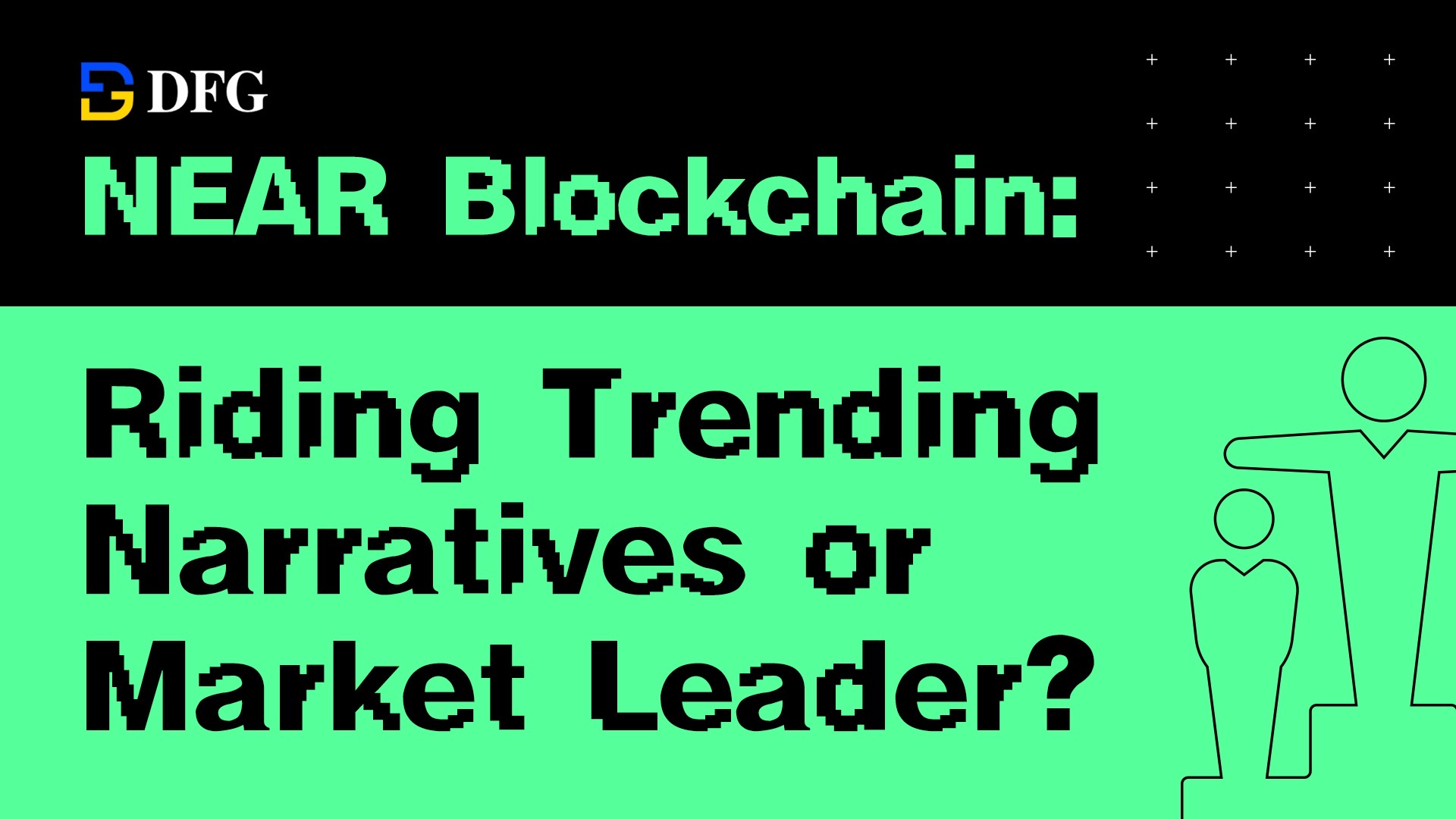
Written by: Geng Kai, Eric, DFG
NEAR has quickly become a leader in the increasingly integrated world of Web3 and AI, but its foundations in the AI field run deeper than many realize. Interestingly, NEAR was not initially conceived as a blockchain project. One of its co-founders, Illia Polosukhin, embarked on this journey with a different goal: to create an AI-driven enterprise. Polosukhin was one of eight researchers at Google who introduced the revolutionary Transformer model (a key architecture that powers some of today's most popular AI tools, such as OpenAI's ChatGPT), and he initially sought to advance AI in a different way.
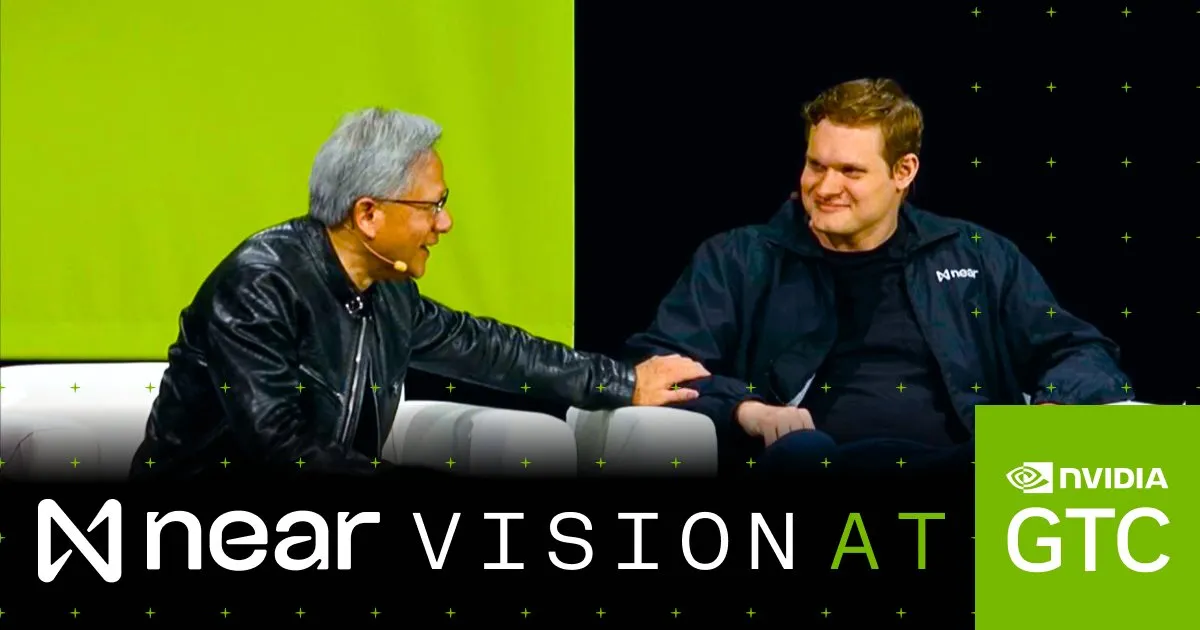
NEAR founder Illia with Nvidia founder Jensen at NVIDIA GTC
However, as the team began their initial AI projects, they encountered significant challenges, particularly in incentivizing and coordinating the various contributors building AI models. It was this barrier that made them realize: blockchain technology could provide the perfect solution. By leveraging a high-performance blockchain with integrated crypto payments, they could facilitate the seamless exchange of essential data, computation, and AI models—key features for building an exceptional decentralized AI ecosystem. This insight prompted a critical shift from AI to blockchain, ultimately giving rise to what we now know as the NEAR protocol.
What truly sets NEAR apart is its remarkable alignment with some of the most compelling narratives in today's tech world. Whether the focus is on AI, chain abstraction, achieving modularity through data availability, or scaling through sharding, NEAR's name consistently comes up. This raises an intriguing question: Is NEAR merely following popular trends, or are they genuinely providing innovative products that enhance the blockchain experience?
To answer this question, we must delve deeper into NEAR's infrastructure.
Addressing Blockchain Scalability Issues: NEAR's Approach
Scalability is a challenge faced by blockchain networks, and various solutions are being explored to meet the growing demand for fast and efficient transactions. While some blockchains have implemented technologies such as Layer 2 scaling, sidechains, and state channels, these approaches often come with trade-offs in terms of interoperability, composability, and usability.
Nightshade Sharding 2.0: NEAR's Scalable Backbone
One of NEAR's standout features is its Nightshade sharding technology, which is a core component of the protocol's scalability strategy. Sharding technology divides the blockchain state into smaller, more manageable parts called "shards," each of which can independently process transactions. This design significantly increases the network's throughput without placing the burden of processing all transactions on any single node.
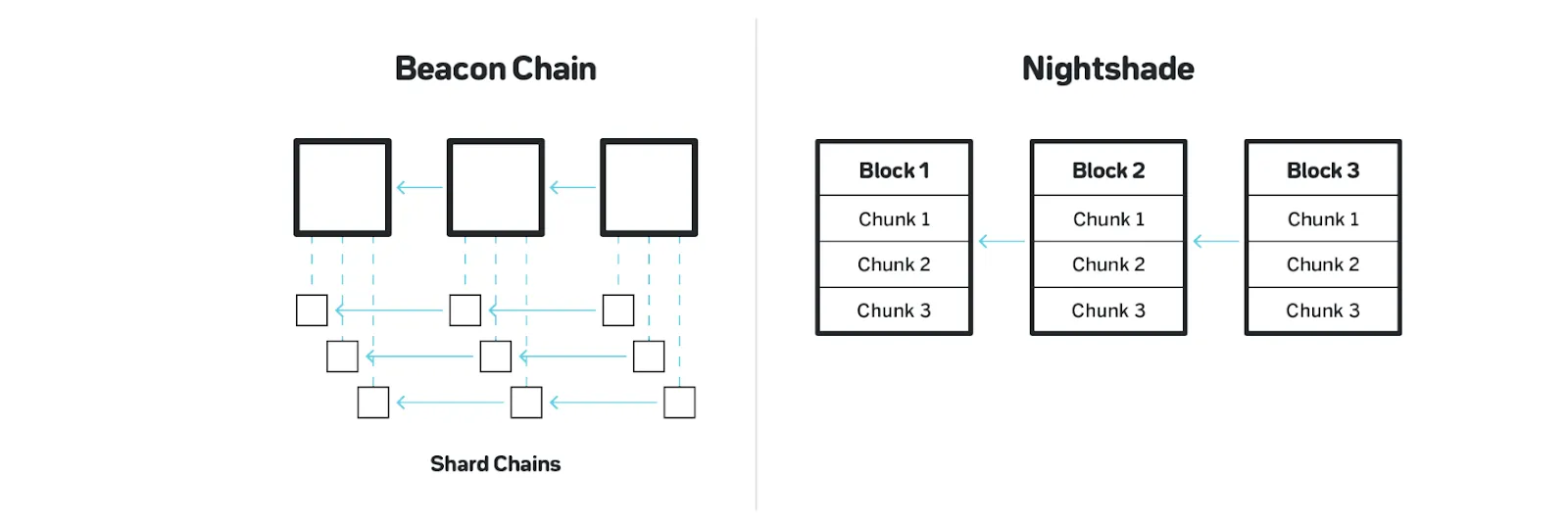
How NEAR blocks are split from each shard
In its initial phase, NEAR implemented a design that divided each block into "chunks," with each chunk containing transactions from a specific shard. Block producers and validators were assigned to specific shards, meaning they only needed to handle transactions related to their shard. This not only optimized processing efficiency but also allowed NEAR to achieve a throughput of approximately 3,000 transactions per second (TPS) with the initial setup of four shards.
As it evolves, NEAR is enhancing this system through stateless validation, allowing validators to verify transactions without storing the entire blockchain state. This innovation reduces hardware requirements, further enhances accessibility, and achieves decentralization of the network. Additionally, NEAR is exploring the integration of zk-proofs (zero-knowledge proofs) and dynamic re-sharding into its sharding design, which can further improve scalability by enabling faster and more secure transaction validation. NEAR will expand to 10 shards by the end of the year, increasing network capacity by 50% to meet growing demand.
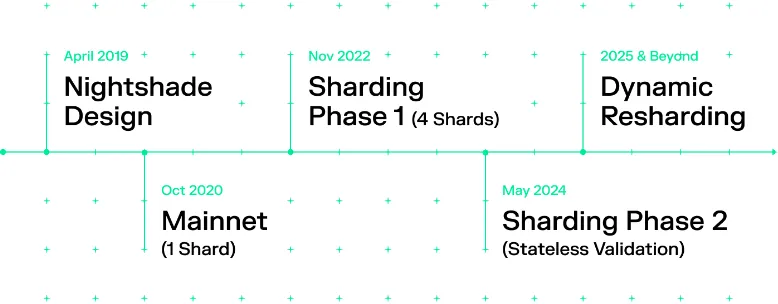
NEAR's Nightshade Sharding provides the scalability, speed, and interoperability needed to support AI projects that require handling large datasets and executing transactions quickly. The network's rapid finality ensures that AI-driven applications can operate in real-time, making NEAR an ideal platform for developers looking to innovate in the decentralized AI space.
NEAR's Full-Stack Modular Architecture for Blockchain Interoperability
As the blockchain landscape becomes increasingly fragmented, the demand for interoperability and seamless cross-chain interactions is more critical than ever. The NEAR protocol recognizes this challenge and has built its platform to be a dominant force in unifying multi-chain ecosystems. By implementing a range of innovative technologies—such as fast data availability (DA) layers, multi-party computation (MPC) for secure cross-chain transactions, super-fast finality layers (SFFL), and chain abstraction—NEAR aims to provide a unified and user-friendly experience across multiple blockchains. Each of these components plays a crucial role in positioning NEAR as a top interoperable blockchain.
Enhancing Cross-Chain Compatibility and Connectivity
NEAR's commitment to interoperability is further exemplified by its integration with Ethereum and the broader blockchain ecosystem. Aurora is a smart contract on NEAR that is an Ethereum-compatible blockchain and ecosystem. The Aurora engine runtime supports the seamless deployment of Solidity and Vyper smart contracts, allowing developers to leverage NEAR's powerful infrastructure while maintaining compatibility with Ethereum. NEAR is compatible with popular tools like Metamask through NEAR Snap, while the Rainbow Bridge facilitates the transfer of tokens and data between Ethereum, NEAR, and Aurora, highlighting its commitment to interoperability.
In addition to maintaining interoperability with other ecosystems, NEAR also provides assets for seamless cross-chain usage through restaking. Allstake allows cross-chain native restaking of assets, creating a trustless decentralized ecosystem that contributes to the security of AVS. By restaking on the NEAR protocol through Allstake, liquidity from multiple ecosystems can be utilized to create a seamless cross-blockchain experience.
The Fastest Data Availability Layer on the Market
NEAR's DA layer is managed by Nuffle Labs (the team behind all of NEAR's modular products) and ensures that the blockchain can efficiently access and process large amounts of data. With Nightshade, NEAR DA provides a robust solution for Ethereum rollups and other high-transaction-volume projects. Unlike other DA solutions, NEAR's consensus mechanism maintains speed even under heavy data influx, ensuring rapid data release and querying.
Overview of Popular DA Solutions:
NEAR DA
Celestia
Avail
EigenDA
Consensus
Nightshade
Tendermint
GRANDPA + BABE
Committee-based
Cost per block
Very low
Low
Low
TBD
Data throughput
16mb/s
6.67mb/s
-
1.39mb/s
Block time
1s
15s
20s
NA
Finalization time
2s
15s
20s
12min
DA sampling
No
Yes
Yes
No
As more and more blockchains use zero-knowledge proofs to achieve unified security across chains, NEAR's DA provides dApps from multiple networks with easier and cheaper data querying and settlement. Additionally, NEAR DA ensures that nodes can remain synchronized even when operators are offline, adding a layer of reliability. This feature benefits not only the currently high-demand applications but also positions NEAR as a key player in future cross-chain settlements.
Supporting Other Blockchain Infrastructures with Super-Fast Finality Layer
According to modular blockchain theory, NEAR has partnered with Eigenlayer to develop the Super-Fast Finality Layer (SFFL). This innovative settlement layer significantly reduces transaction times and Rollup costs, while inheriting the security and finality of NEAR and Ethereum through Eigenlayer. SFFL relies on NEAR DA to obtain transaction data, enabling nodes to efficiently access and verify transactions.
Since SFFL supports cross-rollup transactions, it has boosted NEAR's transaction volume, and with 70% of transaction fees being burned, it has created a deflationary effect on NEAR tokens. The collaboration with Swell further strengthens NEAR's position in the modular blockchain stack, as it has delegated a significant amount of ETH to SFFL, bringing the vision of chain abstraction closer to reality.
Unifying Blockchain: NEAR's Vision of Chain Abstraction
The modular blockchain architecture achieves scalability but also leads to fragmentation, causing liquidity, user experience, and interoperability fragmentation. NEAR addresses these challenges by advancing chain abstraction—a concept aimed at providing users with a unified experience across multiple blockchains.
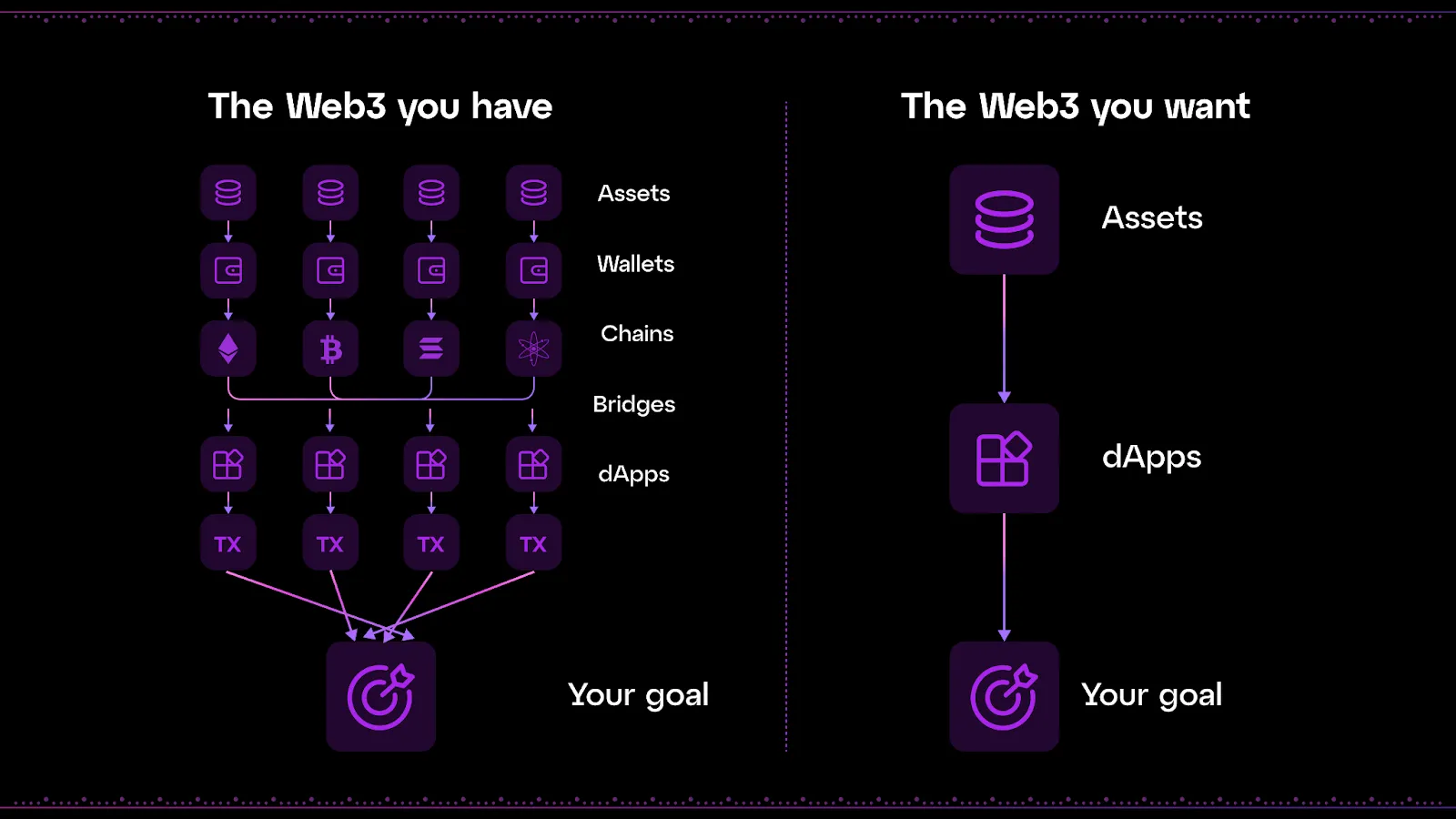
NEAR's FastAuth key management system allows users to manage their NEAR accounts using email addresses, simplifying account creation and recovery. The system also supports multiple keys for different functions, enhancing security and usability.
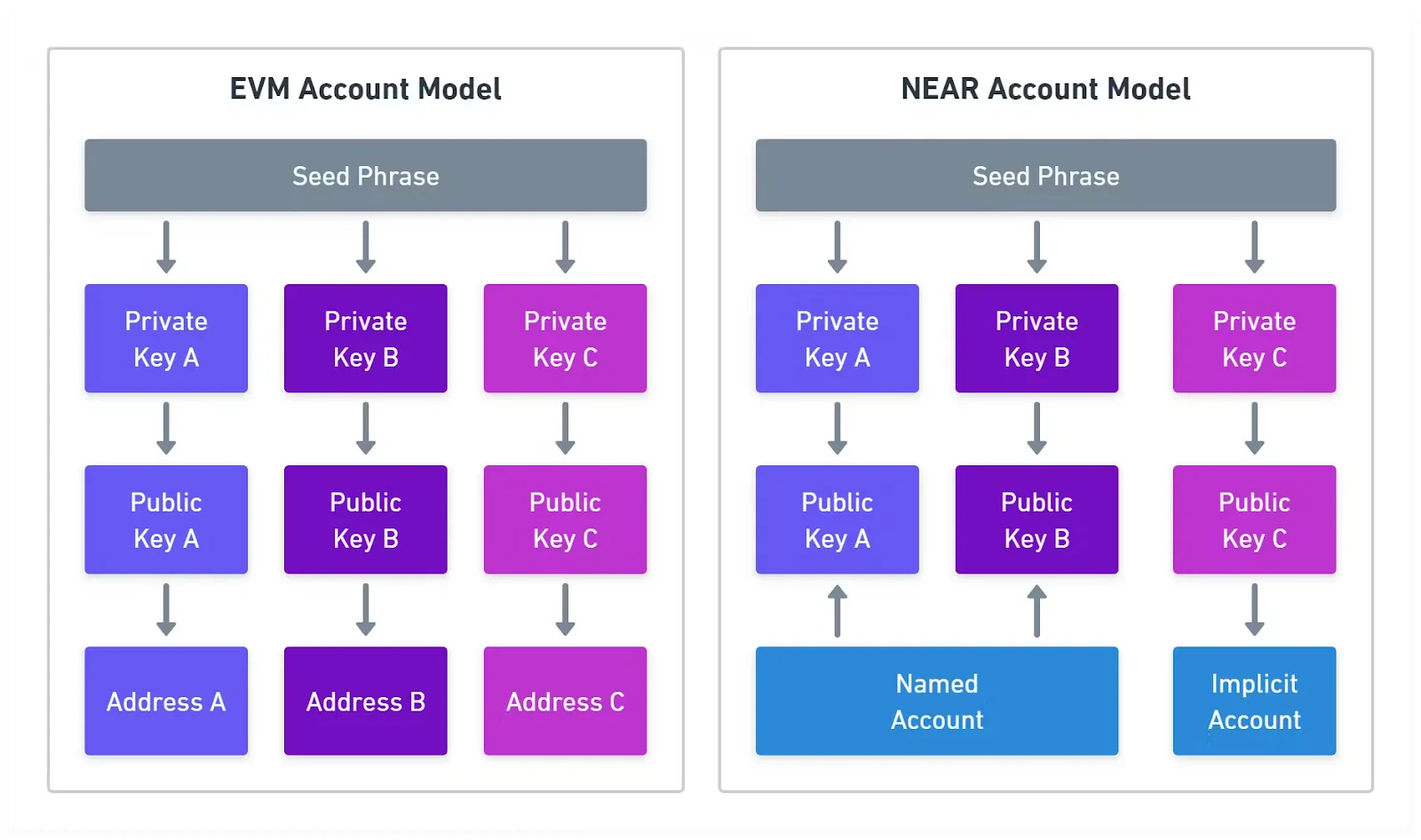
How different keys control different functions on NEAR accounts
Additionally, NEAR integrates MPC technology through chain signatures, ensuring the security of cross-chain transactions, allowing users to interact with multiple blockchains without managing different wallets and mnemonic phrases.
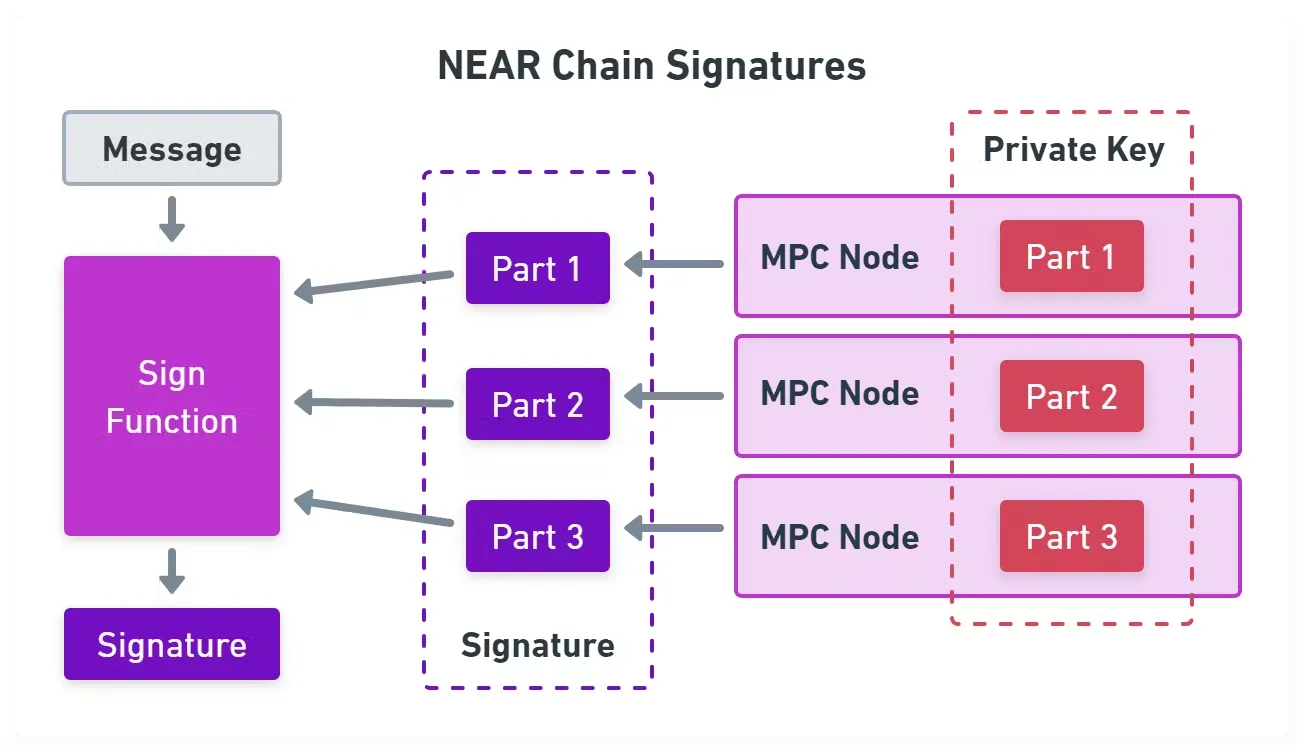
MPC Signature Process
The Appeal of NEAR
Growth of Stablecoins and TVL
Since July 2023, the market capitalization of stablecoins on NEAR has remained relatively stable at around $75 million. However, the beginning of the second quarter of 2024 marked a significant turning point, with the market capitalization of all stablecoins on NEAR experiencing substantial growth. 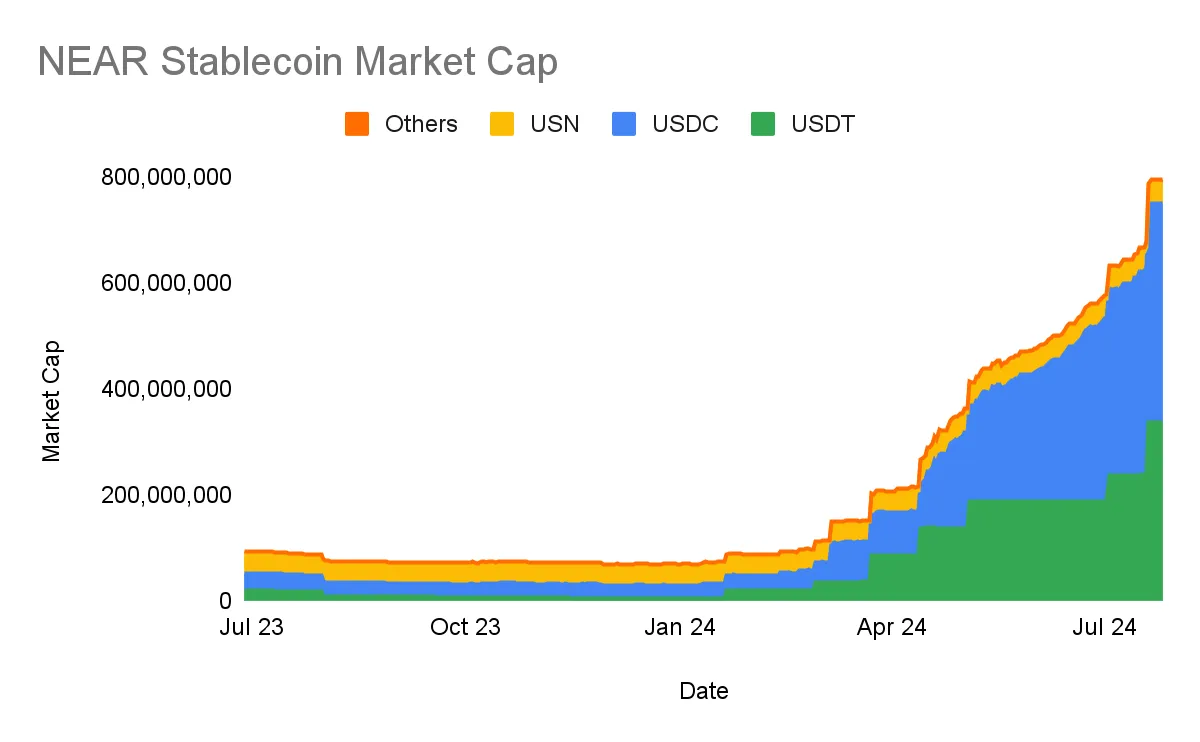
This growth is reflected in the total locked value (TVL) of NEAR and its EVM-compatible sibling, Aurora. From July 2023 to now, the total TVL of NEAR and Aurora has skyrocketed from about $55 million to $230 million, representing a threefold year-over-year increase in dollar terms. After adjusting for the value of native tokens, the TVL calculated in NEAR has doubled, while the TVL calculated in AURORA has decreased by 40%.
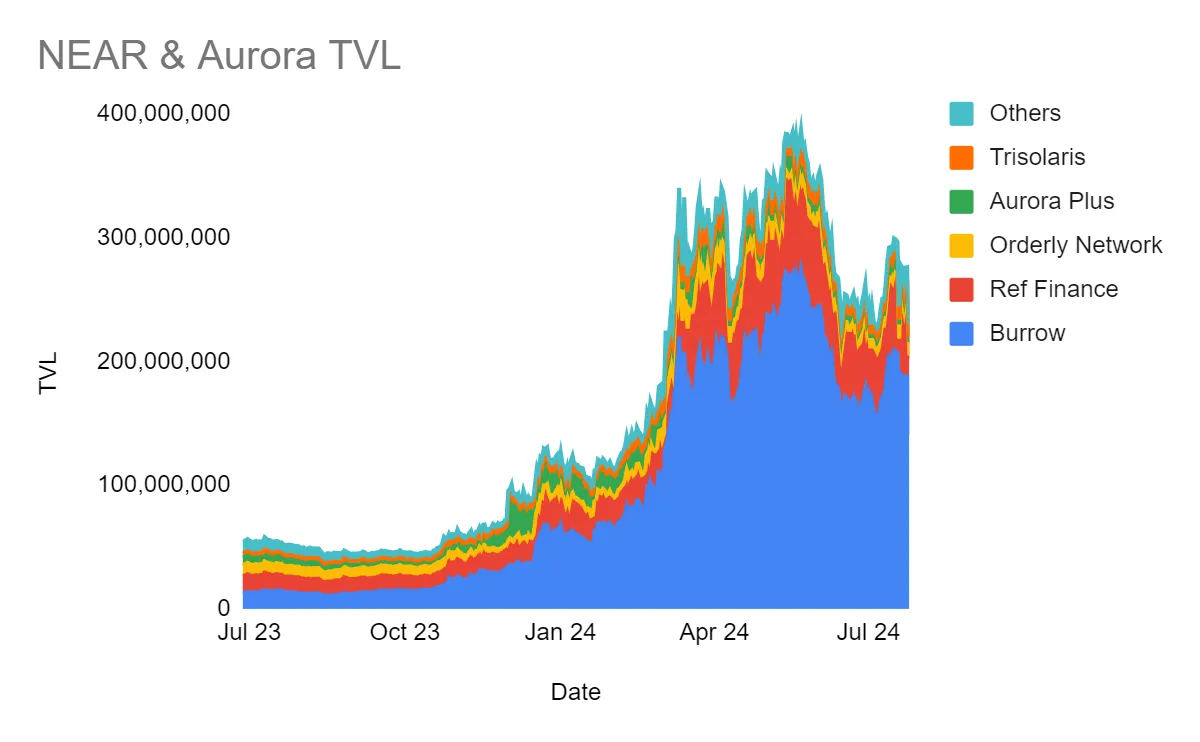
DeFi on NEAR
The DeFi landscape on NEAR is currently dominated by two key platforms: Burrow and Ref Finance. The lending platform Burrow has seen a significant increase in activity due to its incentivized lending program for stablecoins. Similarly, the decentralized exchange (DEX) Ref Finance is actively incentivizing its stablecoin mining pools, recently surpassing a total trading volume of $7 billion. These incentives are primarily funded by NEAR token rewards, which may play a crucial role in the surge of stablecoin market capitalization in 2024.
Emerging Categories and Trends in the NEAR Ecosystem
Restaking
Restaking has emerged as a growing category within the NEAR DeFi ecosystem, with platforms like Allstake contributing approximately $15 million to TVL. Although liquid staking is typically not included in TVL metrics, it remains the largest category, with a TVL exceeding $280 million.
On the Aurora side, while there are several popular EVM dApps, the most widely used application remains Aurora Plus, a platform designed for fee-free transactions and promoting AURORA token staking.
NEAR's Commitment to Web3 AI Development
As part of a broader strategy to become a leading AI platform in the Web3 ecosystem, NEAR is making significant strides in developing and nurturing AI projects on its network. In addition to the efforts of NEAR's R&D labs, the protocol has launched the NEAR AI x Horizon (HZN) incubation program specifically aimed at supporting groundbreaking projects at the intersection of AI and blockchain technology. In its first batch of incubated projects, the program provides equity-free guidance, technical assistance, and scaling innovation support to six selected projects.
The equity-free model of NEAR HZN allows AI projects to focus entirely on building and improving their products without the pressure of relinquishing ownership. This supportive environment is crucial for fostering innovation and has proven successful, as evidenced by previous cohorts that collectively raised over $20 million in external capital. The program begins a new round of funding every May and runs three times a year, aiming to incubate a continuous stream of groundbreaking AI projects.
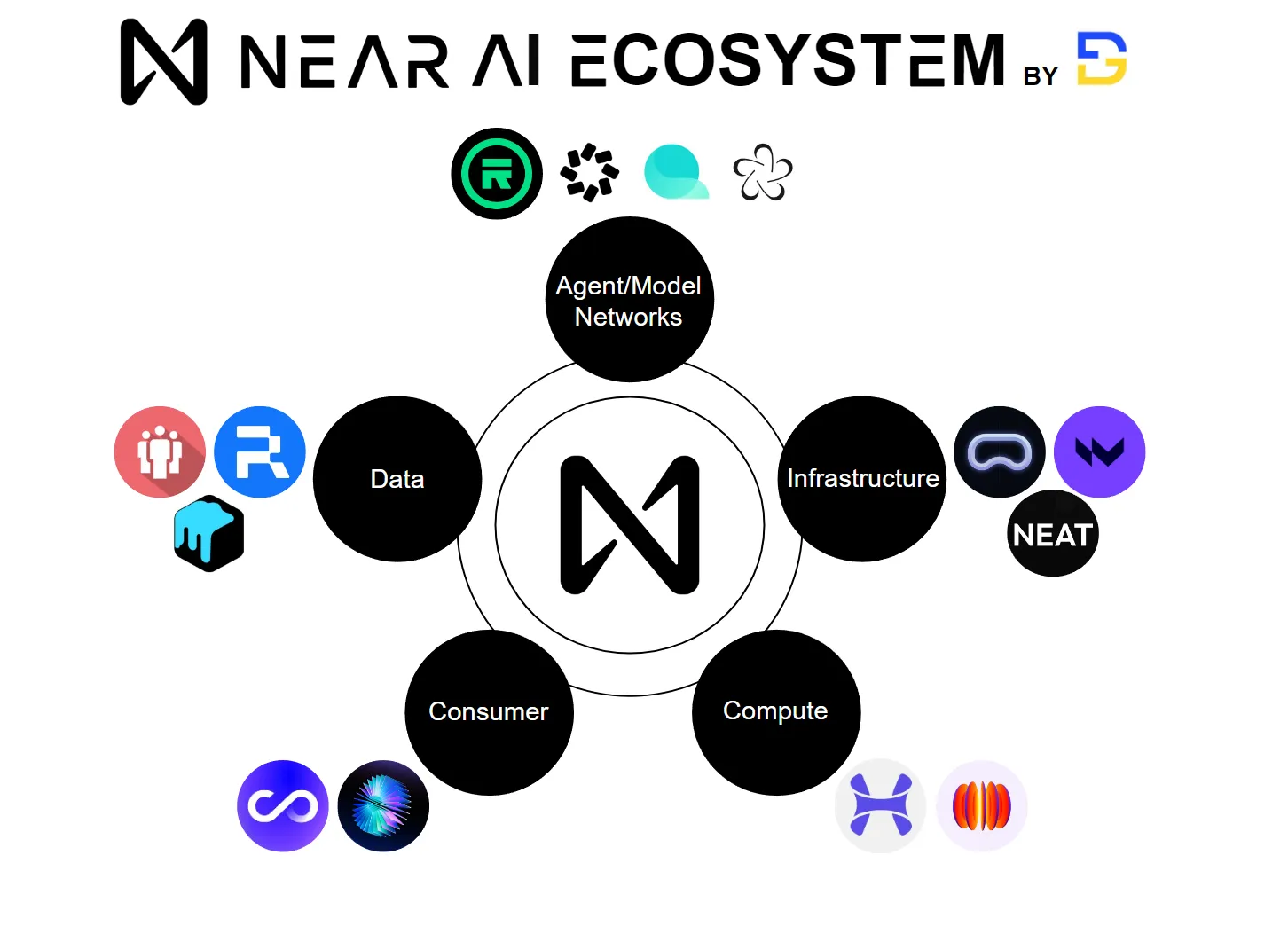
The six projects currently supported by the NEAR HZN program cover key areas of the AI x Web3 stack, including data, computing resources, model networks, and payment infrastructure. These initiatives complement NEAR's collaborations with other AI-focused projects that are building networks in areas such as AI consumer applications and agent infrastructure, and scaling AI through NEAR's data availability (DA) layer.
By addressing all aspects of AI architecture within the Web3 space, NEAR positions itself as the preferred blockchain for developing AI applications. Its comprehensive support system—from incubation programs to cutting-edge technological infrastructure—demonstrates NEAR's commitment to fostering the growth of AI on its platform, ultimately bridging the gap between AI and decentralized technology.
Conclusion: NEAR's Strategic Positioning as a Leader in Blockchain and AI
The NEAR protocol not only follows the trends of popular narratives but also lays the groundwork for the future of blockchain and AI through its innovative and extensive infrastructure. By integrating powerful data availability layers, cutting-edge finality layers, and zero-knowledge technologies, NEAR has become a vital component of the infrastructure that benefits its ecosystem and the broader blockchain space.
NEAR's roots in AI and its pivot to blockchain indicate a profound understanding of both fields. The scalable and reliable infrastructure it develops enables NEAR to refocus on AI and provides the necessary foundation for driving significant advancements that were previously unattainable. With features like chain abstraction, NEAR simplifies multi-chain interactions, making it an ideal platform for AI development that requires seamless access to various blockchains and rapid transactions.
Even in a competitive environment, NEAR remains committed to its promises. Under the leadership of its co-founders, strategic partnerships, and dedicated R&D labs, NEAR is positioning itself as a true leader at the intersection of blockchain and AI. This is not just about keeping up with trends; it is about shaping the future of technology in a way that drives meaningful progress and adoption.
免责声明:本文章仅代表作者个人观点,不代表本平台的立场和观点。本文章仅供信息分享,不构成对任何人的任何投资建议。用户与作者之间的任何争议,与本平台无关。如网页中刊载的文章或图片涉及侵权,请提供相关的权利证明和身份证明发送邮件到support@aicoin.com,本平台相关工作人员将会进行核查。




